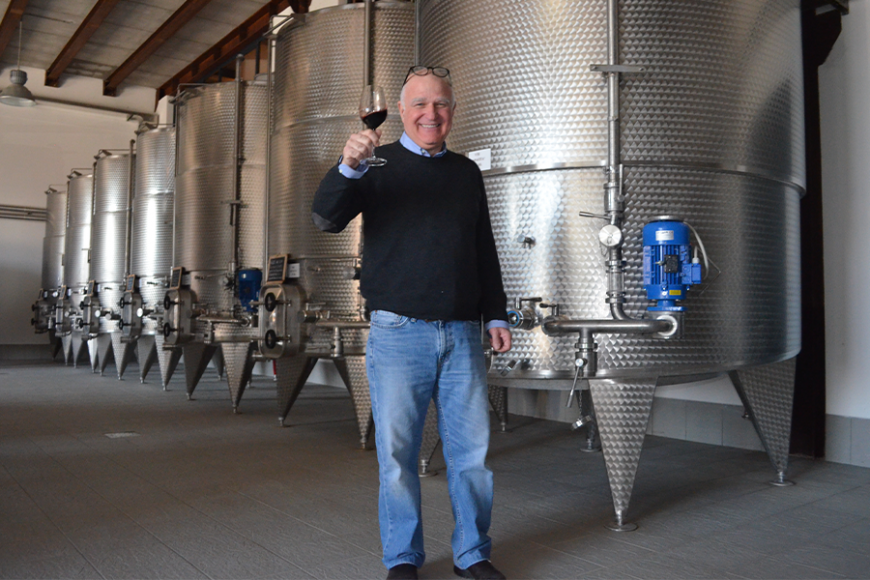(Editor’s note: Doug filed this report as COVID-19 was ramping up. At press time, Italy was closed to tourists and President Donald J. Trump had banned flights to the United States from Europe.)
I was invited to a Sagrantino tasting seminar in New York several years ago, hosted by the Montefalco Sagrantino DOCG. Sagrantino is a thick-skinned but small grape that produces a powerful and nuanced wine. Montefalco is one of the major walled hill towns of the Umbrian region just south of Tuscany and is at the heart of Sagrantino production. And DOCG, of course, is the Denominazione di Origine Contrallata e Garantita, the Italian federal organization that tests and jury-tastes the wines to guarantee the highest quality. I remember the Sagrantino wines we tasted were full-flavored and interesting on the palate but several were overly tannic, almost overwhelming the flavors. I was recently invited to Umbria to taste the just-released 2016 Montefalco Sagrantino and what a treat it was.
Umbria, pronounced “Oombria,” long known as the “Green Heart” of Italy for its omnipresent agriculture, is also quietly known as “Tuscany without the crowds.” It has many small villages and walled hill towns that point to the ancient ways of life in Italy. Churches and town centers that anchor many towns date back many centuries. Just aimlessly wandering through the streets and alleyways, observing and interacting with locals, and taking in the local business ventures is a lovely adventure. From the hilltops the views go on forever, suggesting that peaceful and agrarian way of life tempered by the villages and hill towns borne of social desires and defensive needs.
I tasted many Sagrantino wines and asked several winemakers how they softened the tannins in the past decade and the answers were mostly the same. Liù Pambuffetti of Scacciadiavoli winery told me, “Our tannins would have softened naturally just by the maturing of the vines. Many of the Sagrantino vines were planted in the 1980s and ’90s and even later and the grapes now are more texturally friendly. Also, many producers are employing destemming prior to crushing the grapes and many are using soft press air bladder equipment so the tannic seeds aren’t broken or disturbed. Sagrantino, in the past 10 years, has changed a lot.”
Sagrantino, historically, was used to make a sweet wine known as Passito. The grapes are harvested and left loosely in open baskets or trays in a well-ventilated area to dry and concentrate flavors. These partially raisin-ed grapes are then pressed and fermented into a delightful sweet wine often served with dessert or as dessert. But one producer, Arnaldo Caprai, began in 1971 to make a dry wine with Sagrantino which became popular. In 1988, his son Marco took over and built a beautiful tasting room to receive wine guests, something unheard of in Umbria at the time. All of Arnaldo Caprai Sagrantino wines are carefully hand-harvested and soft-pressed before maturing in new French oak barrels. All of their wines are big and aromatic with dried dark fruit flavors, spices, licorice, pepper and decidedly present, but tame and pleasant, tannins.
The biggest wine producer in Umbria is Lungarotti, now in the hands of the founder’s two daughters. It brings 2.5 million organic bottles to market every year and is exported to 47 countries. And the smallest producer I visited was Ilaria Cocco, making 10,000 bottles each year, her first vintage being 2013. She has a small startup winery and grows grapes on just 3.5 acres. Both mega- and micro- producers of Umbria show quality and flavor in their wines. Ilaria told me, “I don’t cover the fruit with wood. I prefer big barrels to impart texture but not oaky flavors. (With) every vintage I strive to preserve the freshness of the fruit.” Cocco wines are great. She and the winery are going places. And the Lungarotti Rubesco wines have been favorably compared to some of the top iconic wines from all of Italy.
I also visited Tenuta Bellafonte, which translates “place of beauty.” Purchased by Peter Heilbron in 2007, the winery was rebuilt from the ground up, producing its first vintage in 2008. I have been in hundreds of wineries around the world, and I have never seen one as sparkling clean as Tenuta Bellafonte. Even Peter has a striking resemblance to Mr. Clean. The fermentation tank room, the oak barrel room, the visitors’ center and the tasting room, all look and smell as if they were just installed, as if no wine had ever been made there. And the vines are meticulously pruned to an art form. Nothing inside or out is out of place. And the wines — delicious. Virtually all the producers also make a few (or a lot of) white wines out of either Grechetto or Trebbiano Spoletino. Both show lemony citrus, perfumy essence and elegance. Peter said, “In central Italy we get enough from the fruit. We don’t need to add oak flavor. And we don’t press the seeds and the grape skins are empty but intact.”
Giampaolo Tabarrini, owner and winemaker of Tabarrini, is a whirlwind of manic energy whose infectious laugh is entertaining by itself. The winery is toward the end of a major and beautiful rebuild. Again, the winery is spotless and the air in the oak barrel room recycles and renews 72 times per day. The winery is high on a hill with big diurnal temperature swings. Giampaolo is a fifth generation winemaker. His white wines and his red wines are wonderful and worthy. Most of the Umbrian producers also make a Montefalco Rosso, using a blend of Sangiovese, Sagrantino and Merlot or Barbera. All of the Montefalco Rossos I tasted had great fruit flavors and balanced tannins.
Other producers worth looking into are Cantina le Cimate (pronounced chi MA tay), Antonelli, Romanelli, Colleallodole, La Veneranda, and Paolo Bea. Don’t let the long and difficult names deter you. Just look for Montefalco wines. They remain a largely undiscovered product in the shadow of Tuscany, which indicates a great price-to-quality ratio. It’s easy to buy a high quality bottle under $20 and even $12 should bring a well-made and enjoyable experience. Look for some, and now. Drink up. Italy and Umbria need our help. Now.
Write me at doug@dougpaulding.com.


